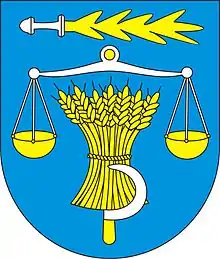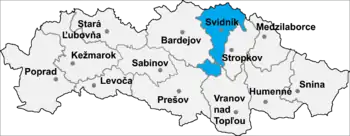Bodružal
Bodružal (spelled Bodružaľ; 1927–1973, Hungarian: Rózsadomb, Rusyn: Бодруджал) is a municipality (village) in Slovakia in the Svidník District in Prešov Region, within the Laborec Highlands.[1][2][3][4][5]

The village, first mentioned in writing in 1600, is best known for housing a Baroque wooden church being a natural cultural monument in Slovakia.
Genealogical resources
The records for genealogical research are available at the state archive "Statny Archiv in Presov, Slovakia"
- Greek Catholic church records (births/marriages/deaths): 1823-1922 (parish A)
_v_obci_Bodru%C5%BEal.jpg.webp) World War I Trench remains in the forest near Bodruzal
World War I Trench remains in the forest near Bodruzal Bodružal in summer
Bodružal in summer Bodruza in the Carpathians
Bodruza in the Carpathians Bodruzal in winter
Bodruzal in winter Bodruzal in spring
Bodruzal in spring
Saint Nicholas Church (Bodruzal)

St. Nicholas Church is a wooden Greek Catholic Church of the Eastern Rite situated in a village Bodruzal in Svidnik district in the Presov region. It is registered on the UNESCO's World Heritage List under an identification number 1273-007 since 8 July 2008.
The church is part of a unique urban entity situated on an elevated place in the village centre. Apart from the church hall, there's a separate bell tower, an adjacent cemetery and a wooden enclosure with a shingle roof and an entrance gate covered by a conical and an onion shape roof.
The church itself is a prototype church of the so-called Lemko type. It dates back to 1658 and belongs to the oldest wooden sacral buildings of the Eastern Rites in Slovakia.
The church has three towers. The construction is made out of logs, in a shape of three squares arranged on the same axis oriented from east to west. The exterior is decorated with vertically laid planks. The logs were also used on the construction of imitation tiered corbelled arches (of a truncated pyramid) in the sanctum and the nave. The arrangement of individual parts of the church represents the Holy Trinity. The church is situated on the highest hillock of the village. With its location it is higher than the rest of the buildings and houses.
The roof is made out of shingles. The tent roof above the presbytery and the nave is finished with a short square structure, to which conical bodies are attached to. To them baroque onion-like little roofs are fixed, finished with small shingle conical heads set with wrought iron crosses.
References
- Registre obnovenej evidencie pozemkov Archived May 14, 2016, at the Wayback Machine. (Bratislava , 2011).
- Počet obyvateľov SR k 31. 12. 2014. Archived January 13, 2016, at the Wayback Machine(Bratislava, 2015).
- Zoznam zvolených starostov a primátorov podľa obcí, miest a mestských častí Archived March 10, 2016, at the Wayback Machine. (Bratislava, 2014).
- Encyklopédia Slovenska ; 1. a 6. zväzok, (Veda, Bratislava 1977 - 1982).
- CAMBEL, Samuel, ed. Dejiny Slovenska II : (1526-1848). 1. vyd. (Bratislava: Veda, 1987).
- Slovensko Dejiny 1 ; Vydavateľstvo Obzor, Bratislava 1971
- Slovensko Príroda 2 ; Vydavateľstvo (Obzor, Bratislava, 1972)
- Slovensko Ľud ; 1. a 2. časť, Vydavateľstvo Obzor, (Bratislava 1974).
